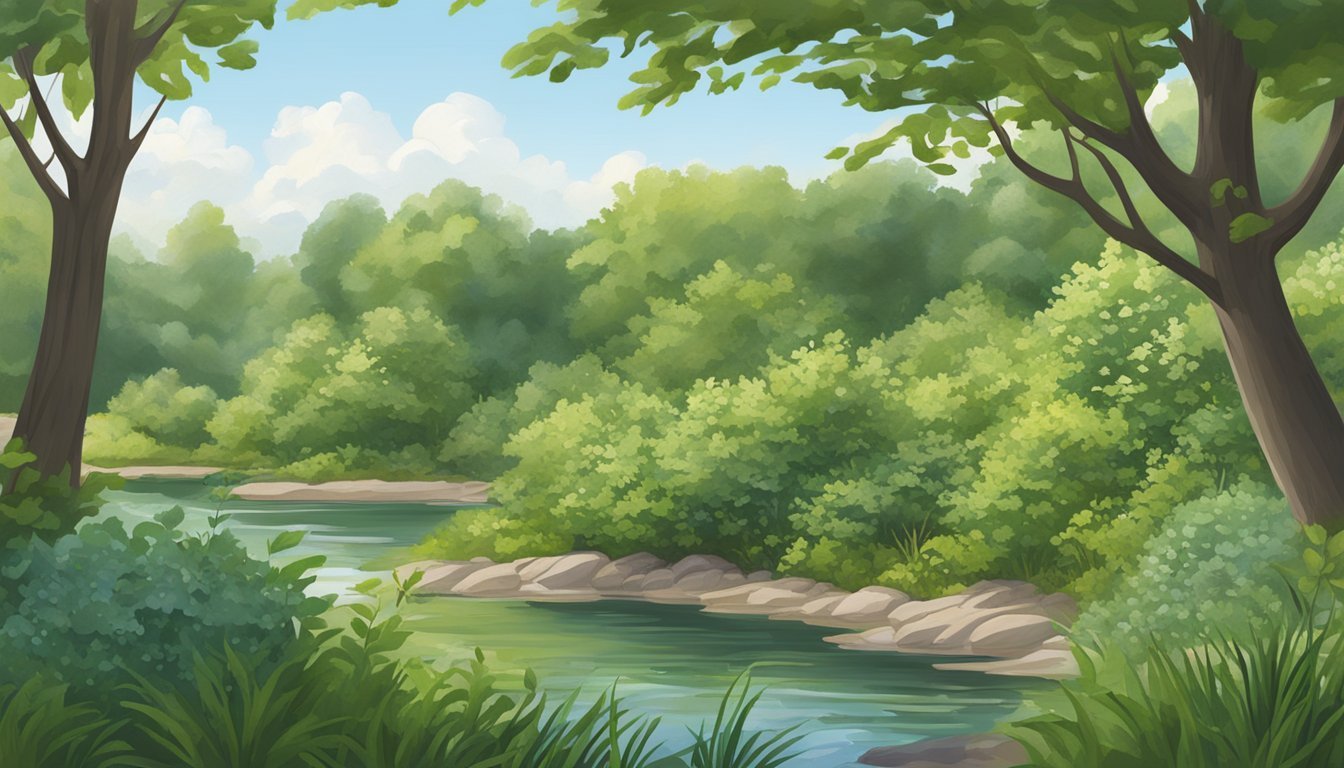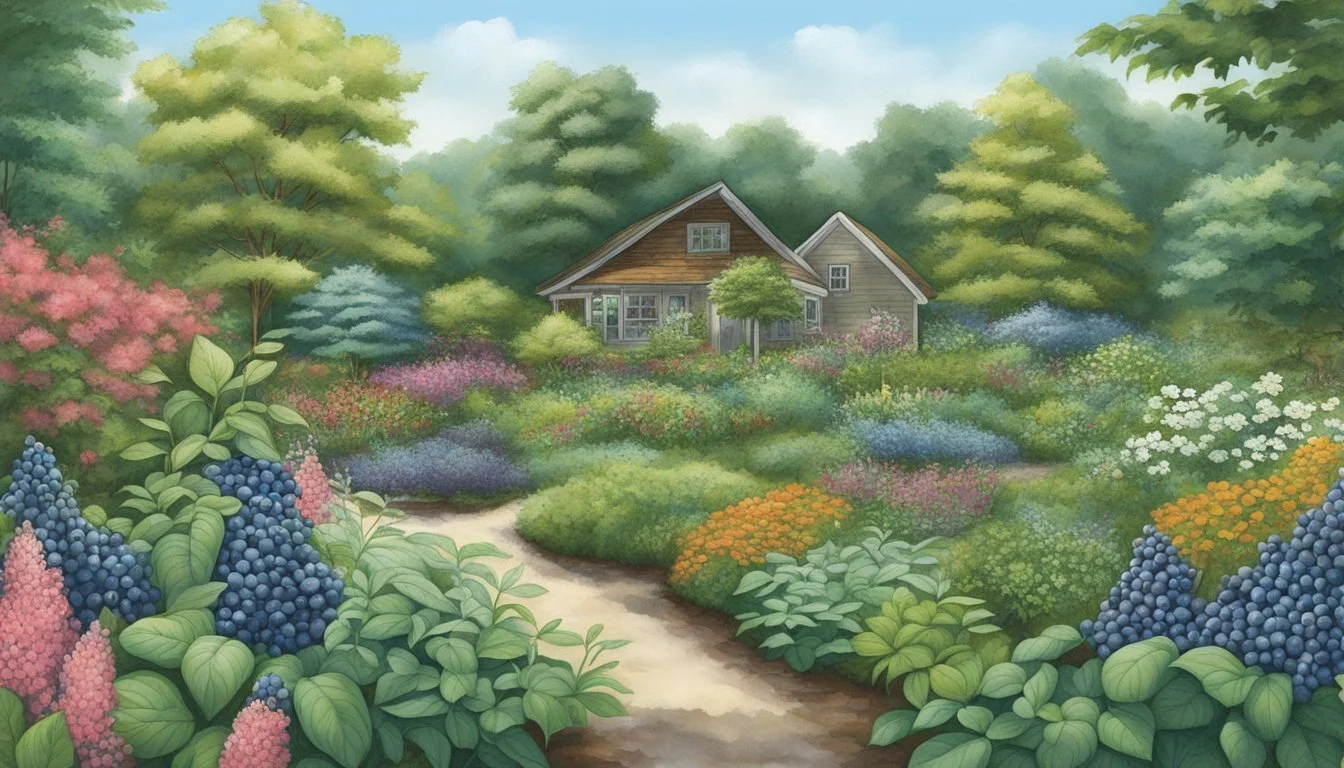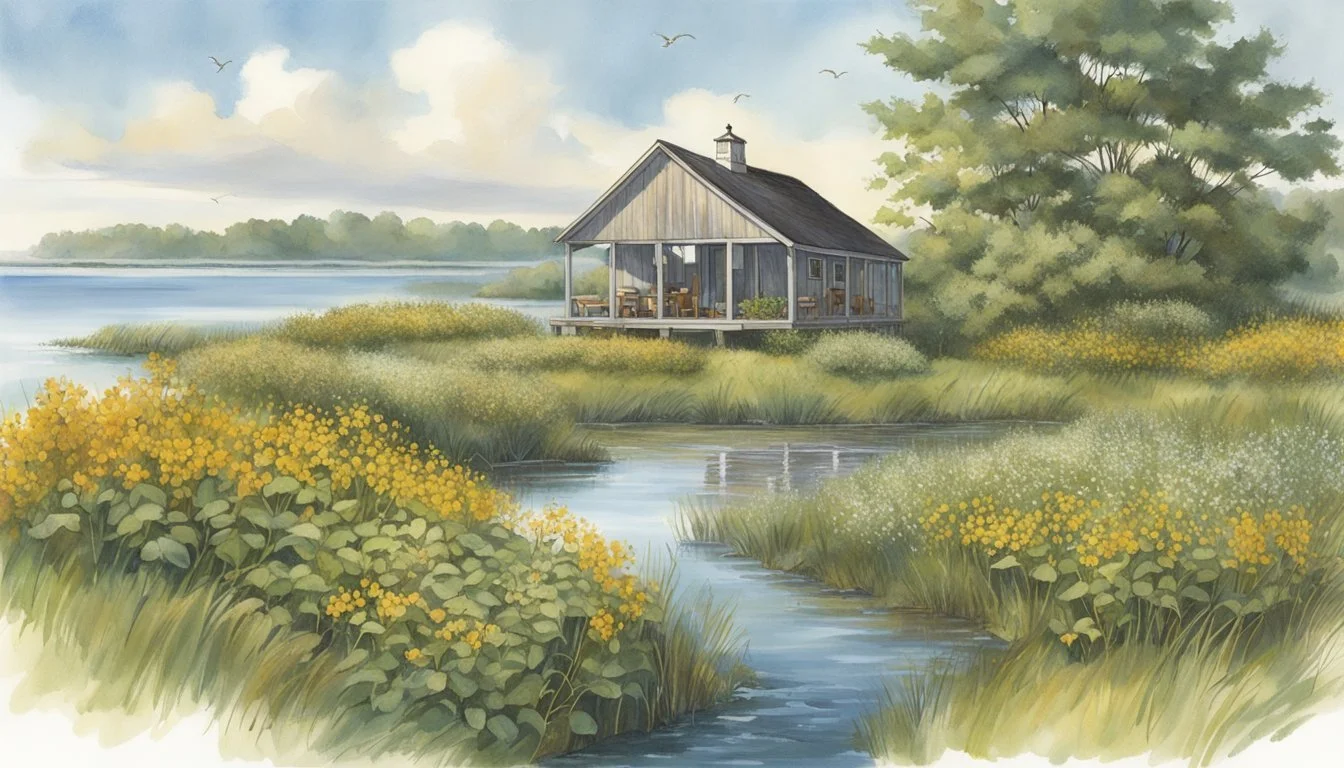Eastern Shore Native Edible Plants
A Guide to Local Foraging
For those seeking to reconnect with nature, exploring native edible plants on Virginia's Eastern Shore offers both adventure and sustenance. This region, particularly Accomack and Northampton counties, features diverse flora that has thrived long before John Smith's arrival. Discovering these native plants not only supports local ecosystems but also offers delicious and nutritious options for foraging enthusiasts.
Key native edible plants include Wild Strawberries (Frageria virginiana and F. vesca), which provide a sweet treat from May through July. Additionally, the region boasts Southern Sneezeweed (Helenium flexuosum) and Fragrant Sumac (Rhus aromatica), among others, contributing to unique foraging experiences. These plants not only sustain local wildlife but also bring historical ties and ecological benefits to the area.
For anyone eager to learn more about these hidden treasures, this blog post will guide you through identifying and safely harvesting these native edibles. Embrace the opportunity to enhance your understanding of the Eastern Shore's native landscape and enrich your diet with its natural offerings.
Historical Significance
The importance of native edible plants in the Eastern Shore extends from Native American traditions to colonial practices, and continues to reflect the area's unique local ecology.
Native American Usage
Native American tribes, such as the Piscataway, traditionally relied on the Eastern Shore's native plants for both nutritional and medicinal purposes. Plants like pawpaw (Asimina triloba) and American persimmon (Diospyros virginiana) were staples in their diets. These fruits provided essential vitamins and minerals, helping to sustain health and wellbeing. Additionally, many wild berries, including blueberries and blackberries, were gathered for their rich fiber and antioxidant contents.
Medicinal uses of native plants were also common. For example, the leaves of violets, known for their high vitamin C content, were often used in herbal remedies. The local ecology played a pivotal role, with specific plant species well-adapted to the region's climate and soil conditions, making them reliable resources for the indigenous populations.
Colonial Utilization
During the colonial era, settlers adopted many native plants into their own diets and agricultural practices. Colonists quickly recognized the nutritional value of these plants. For instance, berries and medicinal herbs such as violets and coneflowers (Echinacea purpurea) became essential in daily life. Settlers learned from Native Americans to forage for and cultivate several species, incorporating them into gardens and farms.
Colonial kitchens frequently used native herbs in cooking and medicine. Recipes from this period highlight the use of native species, often merging European techniques with local ingredients. The Virginia Native Plant Society has documented many such practices, showcasing the blend of local and European agricultural knowledge. This period marked a significant integration of the native flora into the colonial food systems, shaping the region’s culinary and medicinal traditions.
The Importance of Native Plants
Native plants play a critical role in maintaining local ecosystems, supporting biodiversity, and offering economic benefits to communities. Their adaptability to local conditions fosters resilience and sustainability in the environment.
Biodiversity and Local Ecology
Native plants are deeply entwined with the local ecology. They co-evolved with local wildlife, creating interdependent relationships that sustain diverse flora and fauna. For example, native plants in Virginia’s Eastern Shore, adapted to the specific regional soils and climate conditions, provide essential habitats and food sources for various species.
These plants contribute to soil health and stability by promoting diverse microbial communities and preventing erosion. Preserving native plant species helps maintain the ecological balance, ensuring the survival of numerous dependent wildlife species. The overall biodiversity supported by native plants boosts ecosystem resilience, enabling it to withstand environmental stresses such as drought or disease.
Pollinators and Wildlife
Native plants are crucial for pollinators and wildlife. Pollinators, like bees and butterflies, have evolved alongside these plants, relying on them for nectar and pollen. For instance, common milkweed serves as a vital nectar source for many pollinators on the Eastern Shore. The presence of native plants ensures that these pollinators thrive, which in turn supports broader biodiversity.
Wildlife also benefits from native plants as they provide food, shelter, and breeding grounds. Birds, mammals, and insects use native plants to fulfill their habitat needs. This intricate network supports a healthy and dynamic ecosystem, where each species plays a role in maintaining the environmental balance.
Economic Benefits
Planting native species can lead to significant economic benefits. Native plants generally require less water, fertilizers, and pesticides, which reduces gardening and landscaping costs. Lower maintenance requirements translate into financial savings for homeowners and public authorities managing green spaces.
Moreover, the use of native plants can boost local economies. Nurseries and garden centers that specialize in native species, like Inland Bays Garden Center in Delaware, attract customers interested in sustainable gardening practices. Additionally, thriving ecosystems supported by native plants can enhance property values and promote ecotourism, drawing visitors keen to experience the unique natural beauty of regions like Virginia's Eastern Shore.
Tree-Species Overview
Eastern Shore native edible tree species offer unique advantages for both the environment and local communities. Key species include the majestic White Oak, the versatile Serviceberry, and the adaptable Persimmon, each contributing essential functions to the ecosystem and providing valuable resources.
White Oak
The White Oak (Quercus alba) is a significant tree species found in the Chesapeake Bay Watershed. Known for its strong, durable wood, this oak is also edible. Its acorns, when leached of tannins, serve as a nutritious food source.
White Oaks support wildlife by providing acorns for deer, squirrels, and various bird species. Furthermore, these trees play a crucial role in maintaining soil stability and water quality by reducing erosion and filtering runoff.
Serviceberry
Serviceberry (Amelanchier canadensis), also known as Juneberry, is a versatile native species. This small tree or large shrub produces edible berries that ripen in early summer. The sweet, blueberry-like fruits are enjoyed by both humans and wildlife.
Serviceberries thrive in various soil types and can tolerate wet conditions, making them suitable for different landscape settings. Besides their fruit, Serviceberries are valued for their attractive white spring flowers and vibrant fall colors, enhancing local biodiversity and aesthetic appeal.
Persimmon
Persimmon (Diospyros virginiana) thrives in the warmer regions of the Eastern Shore. Its fruit, which ripens in the fall, is high in vitamins A and C. Unripe persimmons are astringent and require patience to become sweet and edible.
Persimmon trees are hardy and can grow in various soil conditions, from well-drained to somewhat poor soils. The foliage and bark are beneficial to local wildlife, providing food and habitat. They also help in soil conservation by stabilizing the ground and reducing erosion.
Shrubs and Bushes
In the Eastern Shore of Virginia, several native shrubs and bushes provide both ecological and culinary benefits. These species are well-adapted to local conditions and support various forms of wildlife.
Highbush Blueberry
The Highbush Blueberry (Vaccinium corymbosum) is a prominent native shrub found on Virginia's Eastern Shore. It thrives in acidic, well-drained soils and is typically found in wetlands and forests.
Key Characteristics:
Height: Can reach up to 12 feet.
Leaves: Oval-shaped with a glossy, green appearance during the growing season, transitioning to vibrant red in the fall.
Flowers: White to pink, bell-shaped flowers that blossom in spring.
Edible Berries:
Taste: Sweet and tangy, perfect for fresh eating or cooking.
Season: Harvested in late spring to early summer.
Uses: Commonly used in jams, pies, and as fresh fruit.
Highbush Blueberry shrubs also support local wildlife, providing food for birds and small mammals. Maintenance involves regular watering, especially during dry periods, and mulching to retain soil moisture. This species is an excellent choice for both ecological landscaping and home gardening on the Eastern Shore.
Wildflowers and Grasses
Wildflowers and grasses play a crucial role in landscaping on Virginia's Eastern Shore. Native wildflowers offer aesthetic beauty and support local ecosystems. Examples such as the Cardinal Flower (Lobelia cardinalis) thrive in moist, sunny conditions and attract pollinators like hummingbirds.
Grasses native to the region include Panicum virgatum (Switchgrass) and Schizachyrium scoparium (Little Bluestem). These grasses are well-adapted to the local climate and soil. They provide essential habitats for birds and insects, prevent soil erosion, and add structure to garden designs.
To help identify and cultivate these plants, enthusiasts can reference guides published by local organizations. These resources often include photos, descriptions, and growing conditions for each species.
Native plants are integral to sustainable landscaping. By incorporating wildflowers and grasses that are indigenous to the Eastern Shore, gardeners can create vibrant, resilient landscapes that support biodiversity.
Here is a quick reference table for Eastern Shore wildflowers and grasses:
Common Name Scientific Name Growing Conditions Cardinal Flower Lobelia cardinalis Moist, sunny Swamp Milkweed Asclepias incarnata Wet, sunny to partial shade Switchgrass Panicum virgatum Dry to moist, sunny Little Bluestem Schizachyrium scoparium Dry, sunny Butterfly Weed Asclepias tuberosa Dry, sunny
Incorporating these species into your garden promotes the health of local ecosystems and helps preserve the Eastern Shore's natural heritage.
Climbing and Groundcover Plants
The Eastern Shore abounds with native plants that offer both ecological benefits and edible qualities. This section explores climbing plants that are ideally suited for vertical gardening and groundcover plants that can serve as edible additions to your landscape.
Vines
Chayote
Chayote is a perennial vine used in vertical gardening. Known for its edible fruits, it thrives in warm, temperate climates. It requires a sturdy trellis or support structure to climb efficiently. The entire plant is edible, including the young shoots, leaves, and roots.
Scarlet Runner Beans
Scarlet runner beans produce striking ornamental flowers and provide multiple edible parts such as leaves, pods, and dried beans. These vines flourish in rich, well-drained soil with sufficient sunlight and are both practical and visually appealing for gardens.
Climbing Peas
Climbing peas, belonging to the Pisum spp., are cool-weather climbers ideal for temperate climates. They grow best in spring and autumn, needing minimal heat. These vines produce edible pods and seeds and can adapt well to both direct sunlight and partial shade.
Integrating Edible Natives into Landscaping
Incorporating edible native plants in landscaping combines aesthetics with practicality. Gardens that include both ornamental and edible varieties can be both beautiful and functional, providing food and habitat for wildlife.
Regional natives such as Yaupon Holly and Swiss chard can fit seamlessly into garden designs. Yaupon Holly (Ilex vomitoria) offers year-round greenery and its leaves can be used to make tea.
Interplanting techniques blend edible plants with ornamental species to create visually appealing landscapes. For example, herbs like rosemary and thyme integrate easily with flowers, adding both texture and flavor to the garden.
Consider the Virginia Coastal Zone Management Program's guidelines to select plant species that are well adapted to local soil and climate conditions. This ensures healthier plants and supports local wildlife.
Edible natives:
Swiss Chard: Vibrant colors, suitable for borders.
Herbs (Rosemary, Thyme, Sage): Blends well with flowers, useful in the kitchen.
Yaupon Holly: Evergreen foliage, tea leaves.
Use raised beds or designated areas within your yard to group a diverse mix of plants. Integrating edible natives into these areas can support sustainable gardening practices.
Garden Design Techniques:
Interplanting: Mix edible and ornamental plants for a balanced, appealing garden.
Layering: Use ground cover, understory, and canopy layers to optimize space.
Companion Planting: Choose plants that benefit each other.
Attention to layout, plant selection, and maintenance can create a cohesive garden that delivers both aesthetic and practical benefits. This method supports a thriving, resilient garden environment.
Active Conservation Efforts
Active conservation efforts on Virginia's Eastern Shore focus on promoting and planting native species, ensuring ecosystems thrive and local biodiversity is preserved. A significant initiative is the Plant ES Natives Campaign.
Plant ES Natives Campaign
The Plant ES Natives Campaign is a concerted effort to encourage the planting of native species across Accomack and Northampton counties. The campaign seeks to raise awareness about the benefits of native plants, such as their low maintenance requirements and resilience to local climate conditions.
An important aspect of this campaign is the Shore Big Trees program, which highlights and protects notable native trees. The program involves educational activities, tree marker installations, and collaboration with local communities to celebrate and preserve native tree species.
The campaign is funded by the Virginia Coastal Zone Management Program, which supports numerous projects aimed at enhancing coastal ecosystems. Curtis Smith, a key figure in the campaign, has been instrumental in obtaining native plant recommendations and promoting their benefits to the local environment and residents.
Identifying Edible Plants
Knowing how to identify edible plants on the Eastern Shore is essential for safety and sustainability. Key areas to focus on include distinguishing features of leaves and berries.
Leaves
Leaves are a primary identifier for foragers. Edible plants like chicory have distinct long, pointed leaves with wavy edges. Ramps, a type of wild leek, feature broad, green leaves with a garlicky aroma. The leaves of curly dock exhibit a central taproot and should be harvested young for the best taste.
Another plant to note is the purple coneflower. Its leaves feel rough and are arranged alternately on the stem. Recognizing leaf shape, texture, and arrangement can aid in proper identification. Always double-check these characteristics to avoid confusing edible plants with toxic ones.
Berries
Berries provide vital nutrients and are easier to identify due to their distinct colors and growth patterns. Persimmons, found in winter, are orange-to-reddish berries and soften as they ripen. Fragrant sumac produces clusters of red berries with a citrusy taste.
When identifying berries, look for clusters and note their surroundings and leaf structures. For instance, sumac berries grow in cone-shaped clusters atop the plant. Consuming berries should involve verifying the plant through multiple sources to ensure they are safe and non-toxic.
Safety and Ethics of Foraging
Foraging is a rewarding way to connect with nature, but safety and ethics are paramount. Proper identification of plants is crucial to avoid toxic varieties. Rely on trusted guides and photographs to confirm plant species. If in doubt, do not consume the plant.
Respect for nature is essential. Harvest only what you need and leave enough for wildlife and plant regeneration. Avoid over-harvesting to ensure the sustainability of the ecosystem.
Always check local regulations before foraging. Some areas may have restrictions to protect endangered species or habitats. Knowledge of these regulations shows respect for conservation efforts.
Personal safety is another key aspect. Wear appropriate clothing, including long sleeves and pants, to protect against ticks, insects, and sharp plants. Additionally, carry a first aid kit for emergencies.
Use ethical foraging practices by steering clear of polluted areas such as roadsides or industrial sites. Plants from these areas can absorb harmful substances, making them unsafe for consumption.
Leave no trace. Avoid damaging the environment by not trampling plants or disturbing habitats. Pack out all trash and leave the site as you found it.
Engage with the local community. Educate yourself from local foragers and join groups to share knowledge and promote sustainable practices. This encourages responsible foraging and conservation of natural resources.
By adhering to these safety and ethical guidelines, foragers can enjoy the benefits of nature while preserving it for future generations.
Impact on Wildlife and Migration
Native edible plants on the Eastern Shore offer crucial support to local ecosystems by providing essential food sources and habitats.
Migratory Birds
Migratory birds heavily rely on native plants as key sources of nutrition during their long journeys. Plants such as the Canadian serviceberry (Amelanchier), known for its fruits, offer sustenance during critical periods of migration. The native vegetation also provides shelter and nesting spots, ensuring safe stopovers.
These plants attract various insect species, integral to the diet of many birds. As a result, the preservation and restoration of native plant species directly impact the survival and health of migratory bird populations. In turn, healthy migratory bird populations contribute to pollination and seed dispersal, further benefiting the ecosystem.
Local Groups and Societies
Local organizations play a crucial role in promoting native edible plants on the Eastern Shore. By fostering community involvement, these groups help preserve local ecosystems and educate the public on the benefits of native species.
Virginia Native Plant Society
The Virginia Native Plant Society (VNPS) is dedicated to the conservation of Virginia’s native plants. They organize events, workshops, and field trips to educate the community about native species.
VNPS also collaborates with local schools and organizations to integrate native plants into public spaces. Membership benefits include access to expert talks, newsletters, and volunteer opportunities. This society is a vital resource for anyone interested in native plants, offering practical guidance and fostering a community of like-minded individuals.
Richmond Chapter
The Richmond Chapter of the Virginia Native Plant Society focuses on regional efforts to promote native plants. They host monthly meetings featuring expert speakers, and plant identification workshops.
The chapter actively participates in local restoration projects, removing invasive species and planting natives in their place. They also engage with local schools, providing educational materials and hands-on learning experiences for students. Through their efforts, the Richmond Chapter plays a significant role in enhancing biodiversity in the region, making it an essential entity for conservation enthusiasts.












